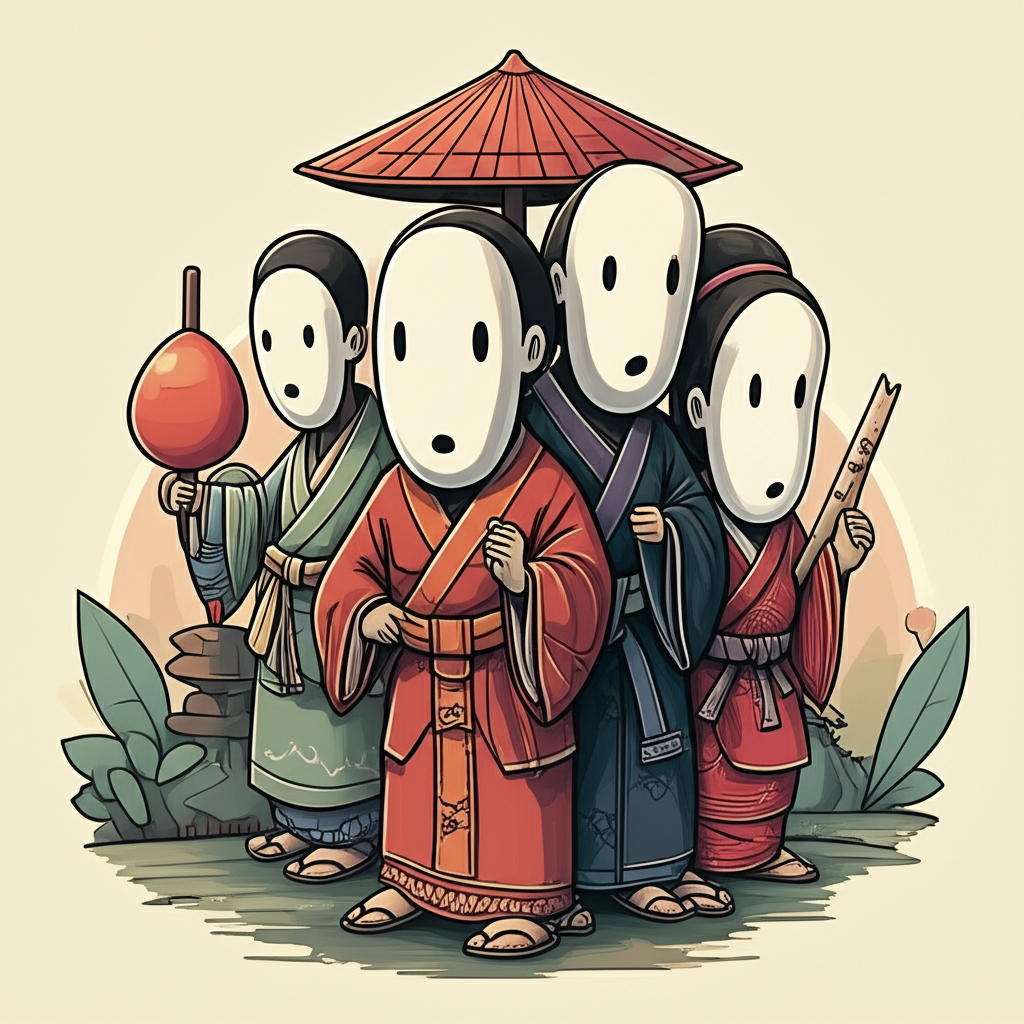
From the misty, mist-shrouded peaks of Japan’s most iconic mountain, Mount Fuji, whispers of ancient tales have long echoed through valleys and across pine-clad slopes. These narratives, woven from the fabric of folklore and passed down through generations, speak not only of the majestic beauty of this sacred volcano but also of the unseen forces that, in the imagination of ancient peoples, guarded its hallowed ground. Among these spectral sentinels, the Noppera-bō, the faceless ghost, holds a peculiar and chilling place in Japanese mythology.
This is a traditional story, a product of the rich cultural tapestry of ancient Japan, shared by people who sought to understand the mysteries of the world around them through the lens of the supernatural. It is a narrative born from a time when the natural world was imbued with a profound sense of spirit and when the boundaries between the tangible and the ethereal were fluid and permeable.
Whispers from a World of Spirits: Origins and Cultural Background
The stories of the Noppera-bō likely took root during periods when Japan was largely agrarian, deeply connected to the cycles of nature, and highly susceptible to the awe and fear inspired by natural phenomena. In such societies, the world was not merely a collection of physical objects; it was alive with spirits, or kami, residing in mountains, rivers, trees, and even inanimate objects. These spirits could be benevolent, bestowing blessings and protection, or malevolent, bringing misfortune and terror.
The awe-inspiring presence of Mount Fuji, a colossal and often unpredictable force of nature, naturally became a focal point for such beliefs. Its snow-capped summit, often hidden in clouds, and its potential for volcanic fury made it a potent symbol of both divine power and raw, untamed nature. In this cultural milieu, it was understandable that people would attribute its guardianship to entities beyond human comprehension. The concept of yōkai, supernatural beings that inhabit the world, provided a framework for understanding these mysterious forces. The Noppera-bō, with its unnerving appearance and unsettling behavior, fit perfectly within this pantheon of the strange and the spectral.
The Void of Identity: Character / Creature Description
The Noppera-bō, as depicted in folklore, is a creature of profound visual absence. It typically manifests as a human figure, often appearing as an elderly woman, though sometimes as a man or even a child. Its defining characteristic, and the source of its chilling name, is its face: it possesses no eyes, nose, or mouth. Where these features should be, there is only smooth, blank skin. This void, this utter lack of discernible features, is what lends the Noppera-bō its unsettling power.
This symbolic attribute speaks not to a physical entity to be worshipped, but to a representation of the unknown, the uncanny, and the unsettling emptiness that can exist where familiarity and recognition should be. The absence of a face can be interpreted as a loss of identity, a detachment from the human world, or a manifestation of a primal fear of the unrecognizable. It is a visual paradox, a human form devoid of its most defining human characteristics.
The Encounter in the Shadows: Main Story / Narrative Retelling
Imagine a traveler, perhaps a weary merchant or a solitary pilgrim, making their way along a dimly lit mountain path as dusk settles over the slopes of Mount Fuji. The air grows cool, and the shadows lengthen, distorting familiar shapes into something more sinister. The traveler, perhaps seeking shelter or simply lost, stumbles upon what appears to be a small, deserted teahouse nestled amongst the trees.
Drawn by a flicker of light within, the traveler approaches, hoping for a moment of respite. As they push open the creaky wooden door, they find a solitary figure seated within, seemingly engaged in a quiet task. It might be an old woman, her back turned, her movements slow and deliberate. The traveler, relieved to find another soul, offers a polite greeting.
The figure slowly turns. And then, the traveler’s blood runs cold. Where a face should be, there is only smooth, featureless skin. No eyes to meet their gaze, no mouth to form a response, no nose to breathe the night air. Just an unnerving, blank expanse.
A tremor of fear, primal and instinctual, grips the traveler. This is no ordinary encounter. The figure, despite its lack of features, might emit a faint sound, a sigh or a soft hum, adding to the disquiet. The traveler, paralyzed by a chilling dread, can only stare, their mind struggling to process the impossible sight.
The Noppera-bō, in its silent, featureless form, does not attack or pursue. Its power lies in its appearance, in the sheer violation of expectation. The traveler, overwhelmed by this surreal and terrifying vision, might flee, scrambling back into the darkness of the mountain, the image of the blank face seared into their memory. Or perhaps, in some tellings, the traveler is simply left to ponder the unsettling encounter, the faceless figure a silent, enigmatic presence that fades back into the ether as silently as it appeared, leaving behind only a lingering sense of unease and a story to tell.
Reflections in the Void: Symbolism and Meaning
To the ancient people who shared these tales, the Noppera-bō likely served as a potent symbol on multiple levels. Its presence on the slopes of Mount Fuji could represent the inherent mysteries and dangers of the natural world, particularly the untamed and unpredictable aspects of the mountain itself. It could embody the fear of the unknown, of encountering something that defies rational explanation or that strips away the familiar markers of humanity.
The facelessness might also symbolize the loss of identity or the dehumanizing effects of fear or isolation. It could serve as a cautionary tale, perhaps warning against straying too far from human settlements or against succumbing to despair when faced with overwhelming circumstances. In a society deeply connected to community and recognition, the complete absence of facial features would be a profound and terrifying disruption of social order and personal identity. The Noppera-bō, therefore, was not just a monster; it was a reflection of deeply held anxieties and a mechanism for processing the unexplainable forces in their lives.
Echoes in the Modern Imagination: Modern Perspective
Today, the Noppera-bō continues to captivate the modern imagination, transcending its origins as a local folktale. It has become a recurring motif in Japanese horror, appearing in literature, manga, anime, and films. Its unnerving appearance and the psychological terror it evokes make it a compelling antagonist for stories that explore themes of fear, identity, and the uncanny.
In video games, the Noppera-bō might be an elusive enemy, its blank face a source of jump scares or a puzzle element requiring players to decipher its true nature. In academic circles, it is studied as a fascinating example of yōkai folklore, offering insights into the beliefs, fears, and storytelling traditions of historical Japan. The Noppera-bō has, in essence, transformed from a guardian of ancient mountains into a cultural icon, a testament to the enduring power of myth and the human fascination with the unsettling and the unknown.
A Legacy of Stories: Conclusion
The tales of the Noppera-bō, the faceless guardians of Mount Fuji, are a testament to the rich cultural heritage of Japan and the enduring human need to make sense of the world through storytelling. These narratives, born from a time when the natural world was imbued with spirits and the unknown held a potent sway, offer a glimpse into the collective imagination of ancient peoples.
As Muslims, we recognize that only Allah is the true Creator and Sustainer of all that exists. Our understanding of the universe is rooted in divine revelation and the acknowledgment of His absolute power and wisdom. These cultural stories, while fascinating and important for historical and educational understanding, are not to be taken as literal truth or as representations of divine power.
Instead, we can appreciate these myths for what they are: vibrant expressions of human creativity, a window into the past, and a reminder of the power of imagination. The enduring presence of figures like the Noppera-bō in our cultural landscape speaks to our shared human experience of wonder, fear, and the eternal quest to understand our place in the vast and mysterious universe. They are echoes of ancient voices, reminding us of the rich tapestry of human tradition and the timeless art of storytelling.





